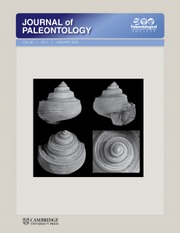Crossref Citations
This article has been cited by the following publications. This list is generated based on data provided by
Crossref.
Rahman, Imran A.
and
Smith, Selena Y.
2014.
Virtual paleontology: computer-aided analysis of fossil form and function.
Journal of Paleontology,
Vol. 88,
Issue. 4,
p.
633.
Benoit, Julien
2015.
A new method of estimating brain mass through cranial capacity in extinct proboscideans to account for the non-neural tissues surrounding their brain.
Journal of Vertebrate Paleontology,
Vol. 35,
Issue. 6,
p.
e991021.
Seguin-Orlando, Andaine
Gamba, Cristina
Sarkissian, Clio Der
Ermini, Luca
Louvel, Guillaume
Boulygina, Eugenia
Sokolov, Alexey
Nedoluzhko, Artem
Lorenzen, Eline D.
Lopez, Patricio
McDonald, H. Gregory
Scott, Eric
Tikhonov, Alexei
Stafford,, Thomas W.
Alfarhan, Ahmed H.
Alquraishi, Saleh A.
Al-Rasheid, Khaled A. S.
Shapiro, Beth
Willerslev, Eske
Prokhortchouk, Egor
and
Orlando, Ludovic
2015.
Pros and cons of methylation-based enrichment methods for ancient DNA.
Scientific Reports,
Vol. 5,
Issue. 1,
Mitsopoulou, Vassiliki
Michailidis, Dimitrios
Theodorou, Evangelos
Isidorou, Stylianos
Roussiakis, Socrates
Vasilopoulos, Theodoros
Polydoras, Stamatios
Kaisarlis, Georgios
Spitas, Vasileios
Stathopoulou, Elizabeth
Provatidis, Christophoros
and
Theodorou, George
2015.
Digitizing, modelling and 3D printing of skeletal digital models of Palaeoloxodon tiliensis (Tilos, Dodecanese, Greece).
Quaternary International,
Vol. 379,
Issue. ,
p.
4.
Carril, Julieta
Tambussi, Claudia Patricia
Degrange, Federico Javier
Benitez Saldivar, María Juliana
and
Picasso, Mariana Beatriz Julieta
2016.
Comparative brain morphology of Neotropical parrots (Aves, Psittaciformes) inferred from virtual 3D endocasts.
Journal of Anatomy,
Vol. 229,
Issue. 2,
p.
239.
Tong, Hao-Wen
and
Chen, Xi
2016.
On newborn calf skulls of Early Pleistocene Mammuthus trogontherii from Shanshenmiaozui in Nihewan Basin, China.
Quaternary International,
Vol. 406,
Issue. ,
p.
57.
Sanders, William J.
2016.
In the Steppes of Central Asia: Mammoth Carcasses, Fossil Flora, and Reconstruction of Northern Siberian Paleoclimate and Paleoecology in the Late Pleistocene.
Journal of Mammalian Evolution,
Vol. 23,
Issue. 2,
p.
219.
Athanassiou, Athanassios
Theodorou, George
Tsoukala, Evangelia
and
Mol, Dick
2016.
VIth International Conference on Mammoths and their Relatives, Part 2.
Quaternary International,
Vol. 406,
Issue. ,
p.
1.
Chen, Xi
and
Tong, Hao-wen
2017.
On the hindfoot bones of Mammuthus trogontherii from Shanshenmiaozui in Nihewan Basin, China.
Quaternary International,
Vol. 445,
Issue. ,
p.
50.
Pečnerová, Patrícia
Díez-del-Molino, David
Dussex, Nicolas
Feuerborn, Tatiana
von Seth, Johanna
van der Plicht, Johannes
Nikolskiy, Pavel
Tikhonov, Alexei
Vartanyan, Sergey
and
Dalén, Love
2017.
Genome-Based Sexing Provides Clues about Behavior and Social Structure in the Woolly Mammoth.
Current Biology,
Vol. 27,
Issue. 22,
p.
3505.
Grigoriev, Semyon E.
Fisher, Daniel C.
Obadă, Theodor
Shirley, Ethan A.
Rountrey, Adam N.
Savvinov, Grigory N.
Garmaeva, Darima K.
Novgorodov, Gavril P.
Cheprasov, Maksim Yu.
Vasilev, Sergei E.
Goncharov, Artemiy E.
Masharskiy, Alexey
Egorova, Viktoriya E.
Petrova, Palmira P.
Egorova, Eya E.
Akhremenko, Yana A.
van der Plicht, Johannes
Galanin, Alexei A.
Fedorov, Sergei E.
Ivanov, Evgeny V.
and
Tikhonov, Alexei N.
2017.
A woolly mammoth ( Mammuthus primigenius ) carcass from Maly Lyakhovsky Island (New Siberian Islands, Russian Federation).
Quaternary International,
Vol. 445,
Issue. ,
p.
89.
Fisher, Daniel C.
2018.
Paleobiology of Pleistocene Proboscideans.
Annual Review of Earth and Planetary Sciences,
Vol. 46,
Issue. 1,
p.
229.
Gastelum-Strozzi, Alfonso
Peláez-Ballestas, Ingris
Cue Castro, Araceli
Rodriguez, Patricia
Dena, Ernesto
López Trujano, Ruby
and
Punzo-Díaz, José Luis
2019.
Non-invasive morphological studies of a tomographic dataset of Funerary Urns from the Middle Balsas region in Michoacán, Mexico.
Journal of Archaeological Science: Reports,
Vol. 28,
Issue. ,
p.
102053.
Benoit, Julien
Legendre, Lucas J.
Tabuce, Rodolphe
Obada, Theodor
Mararescul, Vladislav
and
Manger, Paul
2019.
Brain evolution in Proboscidea (Mammalia, Afrotheria) across the Cenozoic.
Scientific Reports,
Vol. 9,
Issue. 1,
Reynolds, N.
Germonpré, M.
Bessudnov, A. A.
and
Sablin, M. V.
2019.
The Late Gravettian Site of Kostënki 21 Layer III, Russia: a Chronocultural Reassessment Based on a New Interpretation of the Significance of Intra-site Spatial Patterning.
Journal of Paleolithic Archaeology,
Vol. 2,
Issue. 2,
p.
160.
Bennett, Matthew R.
Bustos, David
Belvedere, Matteo
Martinez, Patrick
Reynolds, Sally C.
and
Urban, Tommy
2019.
Soft-sediment deformation below mammoth tracks at White Sands National Monument (New Mexico) with implications for biomechanical inferences from tracks.
Palaeogeography, Palaeoclimatology, Palaeoecology,
Vol. 527,
Issue. ,
p.
25.
Lubeek, Juliën K.
and
Westaway, Kira E.
2020.
Megabeasts under the microscope: a closer look at Quaternary extinctions in the Asia-Pacific.
Quaternary International,
Vol. 568,
Issue. ,
p.
1.
Maschenko, E. N.
Potapova, O. R.
Heintzman, P. D.
Kapp, J. D.
Shapiro, B.
Protopopov, A. V.
Boeskorov, G. G.
Pavlov, I. S.
Plotnikov, V. V.
Kolesov, S. D.
Klimovskiy, A. I.
Kharlamova, A. S.
van der Plicht, J.
and
Agenbroad, L. D.
2021.
Morphology, Individual Age, DNA and Sex of the Yuka Mammoth (Mammuthus primigenius) from Northern Yakutia, Russia.
Paleontological Journal,
Vol. 55,
Issue. 11,
p.
1230.
Diedrich, Cajus G.
2022.
Thick skin cutters of Siberian frozen mummies—The coevolutionary adaptation of Eurasian Ice Age spotted hyenas.
Acta Zoologica,
Vol. 103,
Issue. 2,
p.
220.
Leshchinskiy, Sergey V.
and
Burkanova, Elena M.
2022.
The Volchia Griva mineral oasis as unique locus for research of the mammoth fauna and the late Pleistocene environment in Northern Eurasia.
Quaternary Research,
Vol. 109,
Issue. ,
p.
157.

